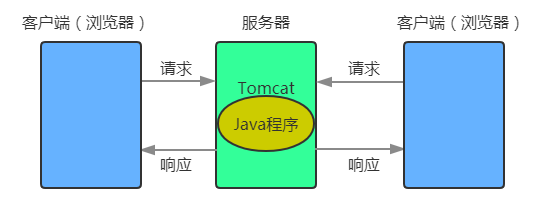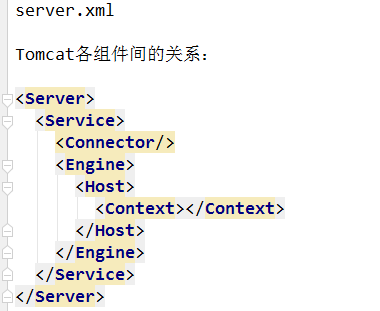Tomcat就是一个服务器,而且是本地的服务器,可以将我们的Java程序放在Tomcat服务器中,就可以用它来完成不同客户端的请求和响应。当Tomcat启动后,客户端发送请求过来,通过在Tomcat上的Java程序完成请求,然后将处理的结果返回给客户端。

一、配置文件说明
各个文件夹的作用
- bin目录:主要是用来存放tomcat的可执行命令,比如启动和停止。命令主要有两大类:以.bat结尾的是windows命令、以.sh结尾的是linux命令。很多环境变量的设置都在此处,例如可以设置JDK路径、TOMCAT路径,startup 用来启动tomcat,shutdown 用来关闭tomcat,修改catalina可以设置tomcat的内存。
- conf目录:主要是用来存放tomcat的一些配置文件。例如端口设置,用户信息配置等。
- lib目录:主要用来存放tomcat运行需要加载的jar包。
- logs目录:用来存放tomcat在运行过程中产生的日志文件,非常重要的是在控制台输出的日志。(清空不会对tomcat运行带来影响)
- temp目录:用来让用户存放tomcat在运行过程中产生的临时文件。(清空不会对tomcat运行带来影响)
- webapps目录:用来存放客户端可以访问的资源,比如Java程序,当tomcat启动时会去加载webapps目录下的应用程序。可以以文件夹、war包、jar包的形式发布应用。【核心目录】
- work目录:用来存放tomcat在运行时的编译后文件,例如JSP编译后的文件。清空work目录,然后重启tomcat,可以达到清除缓存的作用。
conf目录的一些关键配置文件
- server.xml文件:该文件用于配置和server相关的信息,比如tomcat启动的端口号、配置host主机、配置Context。【核心文件】
- web.xml文件:部署描述文件,这个web.xml中描述了一些默认的servlet,部署每个webapp时,都会调用这个文件,配置该web应用的默认servlet。
- tomcat-users.xml文件:配置tomcat的用户密码与权限。
- context.xml:定义web应用的默认行为。
二、Tomcat用户管理
来到tomcat的默认页面,当我们需要通过这个界面来管理我们的应用,或者是我们需要通过远程访问的方式来控制项目的部署等(比如Jenkins远程部署项目到tomcat)这个时候我们就需要一个用户密码来能够远程访问。
tomcat默认没有开启相关配置,当我们点击图中的“Manager App”按钮时会弹出身份认证需要我们输入账号密码,这个时候我们就需要开启用户配置然后配置一个账号密码并给予相应的角色。

在tomcat 主目录/conf/中找到并打开tomcat-users.xml文件配置用户密码和角色,这里我们配置了一个用户名密码都为tomcat的用户,角色给予了3个角色。
<tomcat-users xmlns="http://tomcat.apache.org/xml"
xmlns:xsi="http://www.w3.org/2001/XMLSchema-instance"
xsi:schemaLocation="http://tomcat.apache.org/xml tomcat-users.xsd"
version="1.0">
<role rolename="manager-gui"/>
<role rolename="manager-status"/>
<role rolename="manager-script"/>
<user username="tomcat" password="tomcat" roles="manager-gui, mananger-status,manager-script"/>
</tomcat-users>
角色说明:
- manager-gui:允许访问 html 图形用户接口与状态页面 (即 URL 路径为 /manager/html/* )
- manager-script:允许访问纯文本接口与状态页面 (即 URL 路径为 /manager/text/* )
- manager-jmx: 允许访问JMX代理接口与状态页面 (即 URL 路径为 /manager/jmxproxy/* )
- manager-status:只允许访问 Tomcat 状态页面 (即 URL 路径为 /manager/status/* )
manager-gui、manager-script、manager-jmx 均具备 manager-status 的权限,也就是说,manager-gui、manager-script、manager-jmx 三种角色权限无需再额外添加 manager-status 权限,即可直接访问路径 /manager/status/*。
配置完成后重启tomcat, 然后进入主页点击Manager App输入配置的账号密码。
三、Tomcat的server结构
在Tomcat中比较核心的一个文件就是conf目录下的server.xml文件,它主要包含Tomcat一些核心配置文件,如:启动端口,用户配置,Context等,Tomcat的启动首先就是加载这个文件。
我们打开server.xml看上去很复杂。其实大部分都是注释。下面是一个简图说明了各组件之间的关系!

Tomcat包含的主要组件:服务器Server,服务Service,连接器Connector、引擎Engine、主机Host、上下文Context等。
以下是tomcat 9.0.41 的server.xml源文件:
<?xml version="1.0" encoding="UTF-8"?>
<!--
Licensed to the Apache Software Foundation (ASF) under one or more
contributor license agreements. See the NOTICE file distributed with
this work for additional information regarding copyright ownership.
The ASF licenses this file to You under the Apache License, Version 2.0
(the "License"); you may not use this file except in compliance with
the License. You may obtain a copy of the License at
http://www.apache.org/licenses/LICENSE-2.0
Unless required by applicable law or agreed to in writing, software
distributed under the License is distributed on an "AS IS" BASIS,
WITHOUT WARRANTIES OR CONDITIONS OF ANY KIND, either express or implied.
See the License for the specific language governing permissions and
limitations under the License.
-->
<!-- Note: A "Server" is not itself a "Container", so you may not
define subcomponents such as "Valves" at this level.
Documentation at /docs/config/server.html
-->
<Server port="8005" shutdown="SHUTDOWN">
<Listener className="org.apache.catalina.startup.VersionLoggerListener" />
<!-- Security listener. Documentation at /docs/config/listeners.html
<Listener className="org.apache.catalina.security.SecurityListener" />
-->
<!--APR library loader. Documentation at /docs/apr.html -->
<Listener className="org.apache.catalina.core.AprLifecycleListener" SSLEngine="on" />
<!-- Prevent memory leaks due to use of particular java/javax APIs-->
<Listener className="org.apache.catalina.core.JreMemoryLeakPreventionListener" />
<Listener className="org.apache.catalina.mbeans.GlobalResourcesLifecycleListener" />
<Listener className="org.apache.catalina.core.ThreadLocalLeakPreventionListener" />
<!-- Global JNDI resources
Documentation at /docs/jndi-resources-howto.html
-->
<GlobalNamingResources>
<!-- Editable user database that can also be used by
UserDatabaseRealm to authenticate users
-->
<Resource name="UserDatabase" auth="Container"
type="org.apache.catalina.UserDatabase"
description="User database that can be updated and saved"
factory="org.apache.catalina.users.MemoryUserDatabaseFactory"
pathname="conf/tomcat-users.xml" />
</GlobalNamingResources>
<!-- A "Service" is a collection of one or more "Connectors" that share
a single "Container" Note: A "Service" is not itself a "Container",
so you may not define subcomponents such as "Valves" at this level.
Documentation at /docs/config/service.html
-->
<Service name="Catalina">
<!--The connectors can use a shared executor, you can define one or more named thread pools-->
<!--
<Executor name="tomcatThreadPool" namePrefix="catalina-exec-"
maxThreads="150" minSpareThreads="4"/>
-->
<!-- A "Connector" represents an endpoint by which requests are received
and responses are returned. Documentation at :
Java HTTP Connector: /docs/config/http.html
Java AJP Connector: /docs/config/ajp.html
APR (HTTP/AJP) Connector: /docs/apr.html
Define a non-SSL/TLS HTTP/1.1 Connector on port 8080
-->
<Connector port="8080" protocol="HTTP/1.1"
connectionTimeout="20000"
redirectPort="8443" />
<!-- A "Connector" using the shared thread pool-->
<!--
<Connector executor="tomcatThreadPool"
port="8080" protocol="HTTP/1.1"
connectionTimeout="20000"
redirectPort="8443" />
-->
<!-- Define an SSL/TLS HTTP/1.1 Connector on port 8443
This connector uses the NIO implementation. The default
SSLImplementation will depend on the presence of the APR/native
library and the useOpenSSL attribute of the
AprLifecycleListener.
Either JSSE or OpenSSL style configuration may be used regardless of
the SSLImplementation selected. JSSE style configuration is used below.
-->
<!--
<Connector port="8443" protocol="org.apache.coyote.http11.Http11NioProtocol"
maxThreads="150" SSLEnabled="true">
<SSLHostConfig>
<Certificate certificateKeystoreFile="conf/localhost-rsa.jks"
type="RSA" />
</SSLHostConfig>
</Connector>
-->
<!-- Define an SSL/TLS HTTP/1.1 Connector on port 8443 with HTTP/2
This connector uses the APR/native implementation which always uses
OpenSSL for TLS.
Either JSSE or OpenSSL style configuration may be used. OpenSSL style
configuration is used below.
-->
<!--
<Connector port="8443" protocol="org.apache.coyote.http11.Http11AprProtocol"
maxThreads="150" SSLEnabled="true" >
<UpgradeProtocol className="org.apache.coyote.http2.Http2Protocol" />
<SSLHostConfig>
<Certificate certificateKeyFile="conf/localhost-rsa-key.pem"
certificateFile="conf/localhost-rsa-cert.pem"
certificateChainFile="conf/localhost-rsa-chain.pem"
type="RSA" />
</SSLHostConfig>
</Connector>
-->
<!-- Define an AJP 1.3 Connector on port 8009 -->
<!--
<Connector protocol="AJP/1.3"
address="::1"
port="8009"
redirectPort="8443" />
-->
<!-- An Engine represents the entry point (within Catalina) that processes
every request. The Engine implementation for Tomcat stand alone
analyzes the HTTP headers included with the request, and passes them
on to the appropriate Host (virtual host).
Documentation at /docs/config/engine.html -->
<!-- You should set jvmRoute to support load-balancing via AJP ie :
<Engine name="Catalina" defaultHost="localhost" jvmRoute="jvm1">
-->
<Engine name="Catalina" defaultHost="localhost">
<!--For clustering, please take a look at documentation at:
/docs/cluster-howto.html (simple how to)
/docs/config/cluster.html (reference documentation) -->
<!--
<Cluster className="org.apache.catalina.ha.tcp.SimpleTcpCluster"/>
-->
<!-- Use the LockOutRealm to prevent attempts to guess user passwords
via a brute-force attack -->
<Realm className="org.apache.catalina.realm.LockOutRealm">
<!-- This Realm uses the UserDatabase configured in the global JNDI
resources under the key "UserDatabase". Any edits
that are performed against this UserDatabase are immediately
available for use by the Realm. -->
<Realm className="org.apache.catalina.realm.UserDatabaseRealm"
resourceName="UserDatabase"/>
</Realm>
<Host name="localhost" appBase="webapps"
unpackWARs="true" autoDeploy="true">
<!-- SingleSignOn valve, share authentication between web applications
Documentation at: /docs/config/valve.html -->
<!--
<Valve className="org.apache.catalina.authenticator.SingleSignOn" />
-->
<!-- Access log processes all example.
Documentation at: /docs/config/valve.html
Note: The pattern used is equivalent to using pattern="common" -->
<Valve className="org.apache.catalina.valves.AccessLogValve" directory="logs"
prefix="localhost_access_log" suffix=".txt"
pattern="%h %l %u %t "%r" %s %b" />
</Host>
</Engine>
</Service>
</Server>
Server组件
<Server port=”8005” shutdown=”SHUTDOWN”>这会让Tomcat启动一个server实例(即一个JVM),它监听在8005端口以接收shutdown命令。各Server的定义不能使用同一个端口,这意味着如果在同一个物理机上启动了多个Server实例,必须配置它们使用不同的端口。这个端口的定义用于为管理员提供一个关闭此实例的便捷途径,因此,管理员可以直接telnet至此端口使用SHUTDOWN命令关闭此实例。不过,基于安全角度的考虑,这通常不允许远程进行。
Server的相关属性:
- className: 用于实现此Server容器的完全限定类的名称,默认为org.apache.catalina.core.StandardServer;
- port: 接收shutdown指令的端口,默认仅允许通过本机访问,默认为8005;
- shutdown:发往此Server用于实现关闭tomcat实例的命令字符串,默认为SHUTDOWN;
Service组件
Service主要用于关联一个引擎和与此引擎相关的连接器,每个连接器通过一个特定的端口和协议接收入站请求交将其转发至关联的引擎进行处理。因此,Service要包含一个引擎、一个或多个连接器。
<Service name=”Catalina”>这定义了一个名为Catalina的Service,此名字也会在产生相关的日志信息时记录在日志文件当中。
Service相关的属性:
- className: 用于实现service的类名,一般都是org.apache.catalina.core.StandardService。
- name:此服务的名称,默认为Catalina。
Connector组件
进入Tomcat的请求可以根据Tomcat的工作模式分为如下两类:
-
Tomcat作为应用程序服务器:请求来自于前端的web服务器,这可能是Apache, IIS, Nginx等;
-
Tomcat作为独立服务器:请求来自于web浏览器;
Tomcat应该考虑工作情形并为相应情形下的请求分别定义好需要的连接器才能正确接收来自于客户端的请求。一个引擎可以有一个或多个连接器,以适应多种请求方式。
定义连接器可以使用多种属性,有些属性也只适用于某特定的连接器类型。一般说来,常见于server.xml中的连接器类型通常有4种:
-
HTTP连接器
-
SSL连接器
-
AJP 1.3连接器
-
proxy连接器
如上面示例server.xml中定义的HTTP连接器:
<Connector port="8080" protocol="HTTP/1.1" maxThreads="150" connectionTimeout="20000" redirectPort="8443"/>定义连接器时可以配置的属性非常多,但通常定义HTTP连接器时必须定义的属性只有“port”,定义AJP连接器时必须定义的属性只有"protocol",因为默认的协议为HTTP。以下为常用属性的说明:
-
address:指定连接器监听的地址,默认为所有地址,即0.0.0.0;
-
maxThreads:支持的最大并发连接数,默认为200;
-
port:监听的端口,默认为0;
-
protocol:连接器使用的协议,默认为HTTP/1.1,定义AJP协议时通常为AJP/1.3;
-
redirectPort:如果某连接器支持的协议是HTTP,当接收客户端发来的HTTPS请求时,则转发至此属性定义的端口;
-
connectionTimeout:等待客户端发送请求的超时时间,单位为毫秒,默认为60000,即1分钟;
-
enableLookups:是否通过request.getRemoteHost()进行DNS查询以获取客户端的主机名;默认为true;
-
acceptCount:设置等待队列的最大长度;通常在tomcat所有处理线程均处于繁忙状态时,新发来的请求将被放置于等待队列中;
下面是一个定义了多个属性的SSL连接器:
<Connector port="8443" maxThreads="150" minSpareThreads="25" maxSpareThreads="75"
enableLookups="false" acceptCount="100" debug="0" scheme="https" secure="true" clientAuth="false" sslProtocol="TLS" />Engine组件
Engine是Servlet处理器的一个实例,即servlet引擎,默认为定义在server.xml中的Catalina。Engine需要defaultHost属性来为其定义一个接收所有发往非明确定义虚拟主机的请求的host组件。如前面示例中定义的:
<Engine name="Catalina" defaultHost="localhost">常用的属性定义:
- defaultHost:Tomcat支持基于FQDN的虚拟主机,这些虚拟主机可以通过在Engine容器中定义多个不同的Host组件来实现;但如果此引擎的连接器收到一个发往非非明确定义虚拟主机的请求时则需要将此请求发往一个默认的虚拟主机进行处理,因此,在Engine中定义的多个虚拟主机的主机名称中至少要有一个跟defaultHost定义的主机名称同名;
- name:Engine组件的名称,用于日志和错误信息记录时区别不同的引擎;
注,Engine容器中可以包含Realm、Host、Listener和Valve子容器。
Host组件
位于Engine容器中用于接收请求并进行相应处理的主机或虚拟主机,如前面默认配置文件中定义:
<Host name="localhost" appBase="webapps" unpackWARs="true" autoDeploy="true" xmlValidation="false" xmlNamespaceAware="false"> </Host>常用属性说明:
-
appBase:此Host的webapps目录,即存放非归档的web应用程序的目录或归档后的WAR文件的目录路径;可以使用基于$CATALINA_HOME的相对路径;
-
autoDeploy:在Tomcat处于运行状态时放置于appBase目录中的应用程序文件是否自动进行deploy;默认为true;
-
unpackWars:在启用此webapps时是否对WAR格式的归档文件先进行展开;默认为true;
下面是虚拟主机定义示例:
<Engine name="Catalina" defaultHost="localhost">
<Host name="localhost" appBase="webapps">
<Context path="" docBase="ROOT"/>
<Context path="/bbs" docBase="/web/bss" reloadable="true" crossContext="true"/>
</Host>
<Host name="mail.test.com" appBase="/web/mail">
<Context path="" docBase="ROOT"/>
</Host>
</Engine>主机别名定义:如果一个主机有两个或两个以上的主机名,额外的名称均可以以别名的形式进行定义,如下:
<Host name="www.test.com" appBase="webapps" unpackWARs="true">
<Alias>test.com</Alias>
</Host>Context组件
Context组件是最内层次的组件,它表示Web应用程序本身。配置一个Context最主要的是指定Web应用程序的根目录,以便Servlet容器能够将用户请求发往正确的位置。Context组件也可包含自定义的错误页,以实现在用户访问发生错误时提供友好的提示信息。Context在某些意义上类似于apache中的路径别名,一个Context定义用于标识tomcat实例中的一个Web应用程序;如下面的定义:
<!-- Tomcat Root Context -->
<Context path="" docBase="/web/webapps"/>
<!-- buzzin webapp -->
<Context path="/bbs"docBase="/web/threads/bbs" reloadable="true"></Context>
<!-- chat server -->
<Context path="/chat" docBase="/web/chat"/>
<!-- darian web -->
<Context path="/darian" docBase="darian"/>在Tomcat中,每一个context定义也可以使用一个单独的XML文件进行,其文件的目录为$CATALINA_HOME/conf/<engine name>/<host name>。可以用于Context中的XML元素有Loader,Manager,Realm,Resources和WatchedResource。
常用的属性定义有:
-
docBase:相应的Web应用程序的存放位置;也可以使用相对路径,起始路径为此Context所属Host中appBase定义的路径;切记,docBase的路径名不能与相应的Host中appBase中定义的路径名有包含关系,比如,如果appBase为deploy,而docBase绝不能为deploy-bbs类的名字;
-
path:相对于Web服务器根路径而言的URI;如果为空“”,则表示为此webapp的根路径;如果context定义在一个单独的xml文件中,此属性不需要定义;
-
reloadable:是否允许重新加载此context相关的Web应用程序的类;默认为false;
Realm组件
一个Realm表示一个安全上下文,它是一个授权访问某个给定Context的用户列表和某用户所允许切换的角色相关定义的列表。因此,Realm就像是一个用户和组相关的数据库。定义Realm时惟一必须要提供的属性是classname,它是Realm的多个不同实现,用于表示此Realm认证的用户及角色等认证信息的存放位置。
-
JAASRealm:基于Java Authintication and Authorization Service实现用户认证;
-
JDBCRealm:通过JDBC访问某关系型数据库表实现用户认证;
-
JNDIRealm:基于JNDI使用目录服务实现认证信息的获取;
-
MemoryRealm:查找tomcat-user.xml文件实现用户信息的获取;
-
UserDatabaseRealm:基于UserDatabase文件(通常是tomcat-user.xml)实现用户认证,它实现是一个完全可更新和持久有效的MemoryRealm,因此能够跟标准的MemoryRealm兼容;它通过JNDI实现;
下面是一个常见的使用UserDatabase的配置:
<Realm className=”org.apache.catalina.realm.UserDatabaseRealm” resourceName= “UserDatabase”/>
下面是一个使用JDBC方式获取用户认证信息的配置:
<Realm className="org.apache.catalina.realm.JDBCRealm" debug="99"
driverName="org.gjt.mm.mysql.Driver"
connectionURL="jdbc:mysql://localhost/authority"
connectionName="test" connectionPassword="test"
userTable="users" userNameCol="user_name"
userCredCol="user_pass"
userRoleTable="user_roles" roleNameCol="role_name" />Value组件
Valve类似于过滤器,它可以工作于Engine和Host/Context之间、Host和Context之间以及Context和Web应用程序的某资源之间。一个容器内可以建立多个Valve,而且Valve定义的次序也决定了它们生效的次序。Tomcat中实现了多种不同的Valve:
-
AccessLogValve:访问日志Valve
-
ExtendedAccessValve:扩展功能的访问日志Valve
-
JDBCAccessLogValve:通过JDBC将访问日志信息发送到数据库中;
-
RequestDumperValve:请求转储Valve;
-
RemoteAddrValve:基于远程地址的访问控制;
-
RemoteHostValve:基于远程主机名称的访问控制;
-
SemaphoreValve:用于控制Tomcat主机上任何容器上的并发访问数量;
-
JvmRouteBinderValve:在配置多个Tomcat为以Apache通过mod_proxy或mod_jk作为前端的集群架构中,当期望停止某节点时,可以通过此Valve将用记请求定向至备用节点;使用此Valve,必须使用JvmRouteSessionIDBinderListener;
-
ReplicationValve:专用于Tomcat集群架构中,可以在某个请求的session信息发生更改时触发session数据在各节点间进行复制;
-
SingleSignOn:将两个或多个需要对用户进行认证webapp在认证用户时连接在一起,即一次认证即可访问所有连接在一起的webapp;
-
ClusterSingleSingOn:对SingleSignOn的扩展,专用于Tomcat集群当中,需要结合ClusterSingleSignOnListener进行工作;
RemoteHostValve和RemoteAddrValve可以分别用来实现基于主机名称和基于IP地址的访问控制,控制本身可以通过allow或deny来进行定义,这有点类似于Apache的访问控制功能;如下面的Valve则实现了仅允许本机访问/probe:
<Context path="/probe" docBase="probe">
<Valve className="org.apache.catalina.valves.RemoteAddrValve" allow="127\.0\.0\.1"/>
</Context>其中相关属性定义有:
-
className:相关的java实现的类名,相应于分别应该为org.apache.catalina.valves.RemoteHostValve或org.apache.catalina.valves.RemoteAddrValve;
-
allow:以逗号分开的允许访问的IP地址列表,支持正则表达式,因此,点号“.”用于IP地址时需要转义;仅定义allow项时,非明确allow的地址均被deny;
-
deny: 以逗号分开的禁止访问的IP地址列表,支持正则表达式;使用方式同allow;
Tomcat Server处理一个HTTP请求的过程:
- 用户点击网页内容,请求被发送到本机端口8080,被在那里监听的Coyote HTTP/1.1 Connector获得。
- Connector把该请求交给它所在的Service的Engine来处理,并等待Engine的回应。
- Engine获得请求localhost/test/index.jsp,匹配所有的虚拟主机Host。
- Engine匹配到名为localhost的Host(即使匹配不到也把请求交给该Host处理,因为该Host被定义为该Engine的默认主机),名为localhost的Host获得请求/test/index.jsp,匹配它所拥有的所有的Context。Host匹配到路径为/test的Context(如果匹配不到就把该请求交给路径名为“ ”的Context去处理)。
- path=“/test”的Context获得请求/index.jsp,在它的mapping table中寻找出对应的Servlet。Context匹配到URL PATTERN为*.jsp的Servlet,对应于JspServlet类。
- 构造HttpServletRequest对象和HttpServletResponse对象,作为参数调用JspServlet的doGet()或doPost().执行业务逻辑、数据存储等程序。
- Context把执行完之后的HttpServletResponse对象返回给Host。
- Host把HttpServletResponse对象返回给Engine。
- Engine把HttpServletResponse对象返回Connector。
- Connector把HttpServletResponse对象返回给客户Browser。






















 2258
2258











 被折叠的 条评论
为什么被折叠?
被折叠的 条评论
为什么被折叠?










